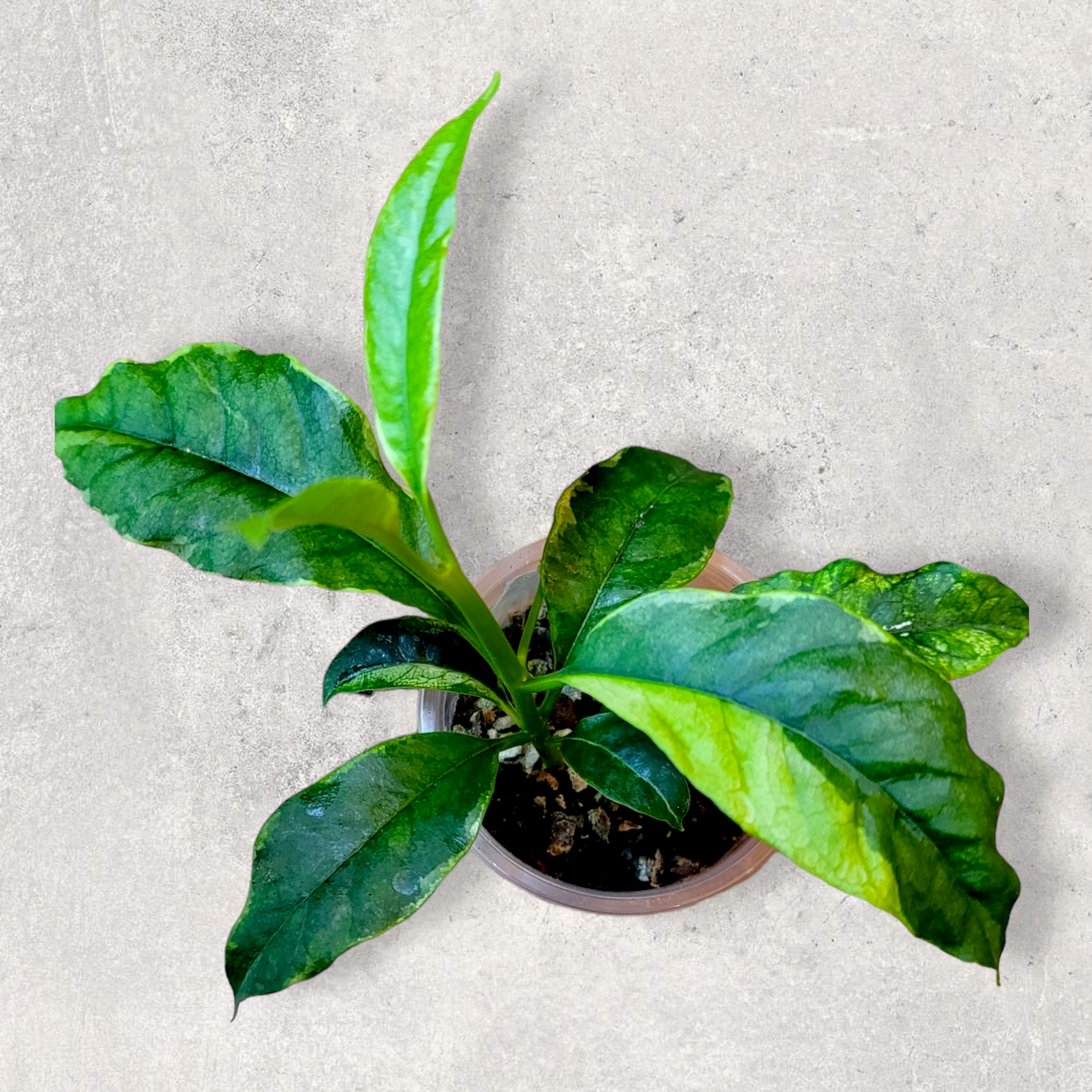
Hoya Multiflora (Outer Margin Variegated)(Albo)
Hoya multiflora (outer margin variegated) is a variegated variety of Hoya multiflora. The Hoya Multiflora is native to Indonesia. Other common names for Hoya multiflora include Wax plant, Porcelain flower, Shooting Star Hoya, and Many Flower Hoya. Its large leaves, sturdy stems, and upright growth pattern give the plant a distinctive presence.
Hoya multiflora (outer margin variegated) features large laves with a light border and multiple shades of green splotches all over the plant.
Flower
Large clusters of star-shaped flowers are present in this Hoya's floral arrangement, which grows and blooms effectively throughout the year.
The inflorescence consists of a number of hanging or more upright flowers arranged in an umbel. The flowers are white and yellow. They appear to be made of wax and are born in clusters with a star-like shape. The surface of the flower is smooth and devoid of the tiny hairs typical of many other Hoya. They may produce extra nectar that drips from the flowers and are strongly scented, with a faint lemon scent.
Hoya multiflora (outer margin variegated) blooms from spurs, just like all other Hoya species. These emerge from the axils of the leaves and stem; they may not bear flowers at first, but eventually buds will appear from the tips of the spurs. These same spurs produce new flowers every season, so they shouldn't be harmed or taken away.
The plant blooms from spring until late summer; on the same peduncle, it can produce umbels of 10 to 30 tiny star-shaped flowers that develop gradually over the course of 2 to 3 weeks. Early in the evening is when the scent is strongest.

Specifications:
Scientific name: Hoya multiflora variegated
Common names: Many Flower Hoya, Shooting Star Hoya
Origin: Indonesia.
Flower colour: White
Genus: Hoya
Family: Apocynaceae (Asclepiadaceae)
Kingdom: Plantae
Type:Flowering vine
How to care for
Hoya multiflora (outer margin variegated)
Hoya multiflora (outer margin variegated) thrives when provided with bright, indirect light, semi-arid conditions and well-draining soil. Despite its uniqueness and tropical nature, this hoya is relatively easy to care for.

Summary:
- Bright indirect light.
- Well-draining soil with organic content.
- Humidity range 60-80%
Hoya multiflora (outer margin variegated) Detail

Light Requirements:
- For optimum growth and flowering, position your plant directly in front of a window. Windows with no direct sunlight at all will do, but your plant will benefit if you can give it a few hours of direct sunlight either in the morning or late in the day.
- You can also use grow lights to cultivate your plant. T5 grow lights are an ideal investment if you are looking to provide your hoya artificial light.
- However, an east or west facing window is the best place for your hoya. If you do not have it, grow lights will also help.

Temperature Requirements:
- Hoya multiflora (outer margin variegated) does well and grow well in temperatures between 18°C and 29°C (64°F to 84°F).
- Your Hoya multiflora (outer margin variegated) vines will therefore thrive at room temperature. Try to prevent abrupt temperature changes for the Hoya multiflora to prevent stress on the plant.
- Keep your Hoya plant away from extremely hot or cold radiators to preserve its health. If you live in a warmer climate and the temperature is suitable, you can keep your Hoya outside.
- However, once the temperatures begin to fall in the fall and winter, you will need to bring your Hoya inside.

Humidity Requirements:
- Between 60 and 80 percent relative humidity is ideal for Hoya multiflora (outer margin variegated) growth. You can also grow these houseplants with lower humidity.
- If you can, use a humidifier; otherwise, place a container filled with water on a pebble tray.
- For your Hoya to have just the right amount of humidity, air quality is also important. Heating in homes keeps the air dry. Therefore, you might need to mist your plants twice a day in the winter. Keep in mind that some Hoya species are more difficult to maintain than others.
- Wilted leaves or slow growth are signs that the humidity needs to be raised. Make sure the soil is just moist enough, and mist the leaves liberally to increase humidity.

Watering Requirements:
- Wait until the top inch (2.5 cm) of soil has dried out before watering your Hoya Multiflora Albomarginatamultiflora (outer margin variegated).
- You should monitor the temperature and humidity levels in the air where your plant is growing so that you will not forget when to water it. The worst thing you can do when taking care of your Hoya plant is to overwater it.
- You run the risk of your plant developing root rot and dying from fungi if you let it sit in wet, soggy soil.
- Pebbles are another option you have if you want better drainage and airflow.
- When the leaves of your Hoya multiflora (outer margin variegated) begin to yellow and feel mushy, that is an undeniable sign that you have overwatered it. Stop watering the plant until the soil has at least partially dried out if you notice the leaves turning yellow and the soil is wet.
- Avoid bottom watering. This can lead to root rot.

Soil Requirements:
- Hoyas require well-draining soil, sphagnum moss, or orchid substrate for adequate growth.
- The ideal potting mixture for hoyas is one part peat, one part perlite, and one part orchid mix.
- This type of soil ensures plenty of airflow to protect the roots and keep them from drying out.
- For the Hoya plant, you ought to use a fast-draining, well-aerated soil. If the soil seems to be hard, add some sand to it to soften it even more.
- Another suitable soil type for hoya growth is cactus mix or succulent potting soil.

Fertilizing Requirements:
- Hoya multiflora (outer margin variegated) does not need a lot of fertiliser to thrive.
- During the growing season, fertilise every two to three weeks with an organic fertiliser (spring and summer).
- It would be best to postpone feeding your plants in the fall and winter when their growth is practically dormant.
- As the Hoya ages, a nitrogen-rich fertiliser can promote wholesome growth. When you notice that your plant is about to flower, switch to a fertiliser that is high in phosphorus to get good, vibrant flowers.
- Between feedings, flush the soil to effectively care for your Hoya and prevent root burn. To achieve this, thoroughly water your succulent houseplant and then let any extra water drain. This flushing aids in preventing the buildup of mineral salts in the soil, which might hinder growth.
FAQ
Use this text to share information about your product or shipping policies.
Do you ship overseas?
Yes, we ship all over the world. Shipping costs will apply, and will be added at checkout. We run discounts and promotions all year, so stay tuned for exclusive deals.
How long will it take to get my orders?
It depends on where you are. Orders processed here will take 5-7 business days to arrive. Overseas deliveries can take anywhere from 7-16 days. Delivery details will be provided in your confirmation email.
Any question?
You can contact us through our contact page! We will be happy to assist you.






